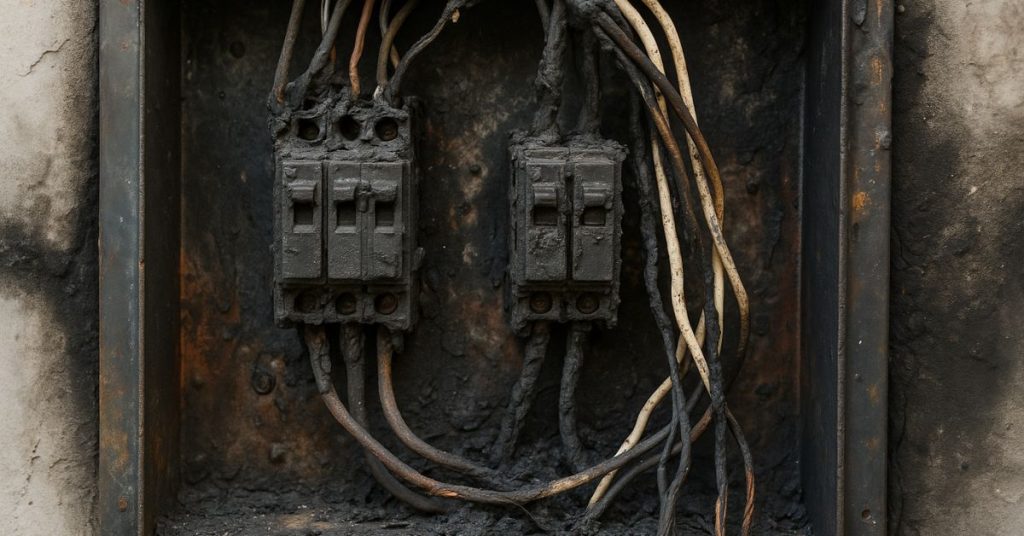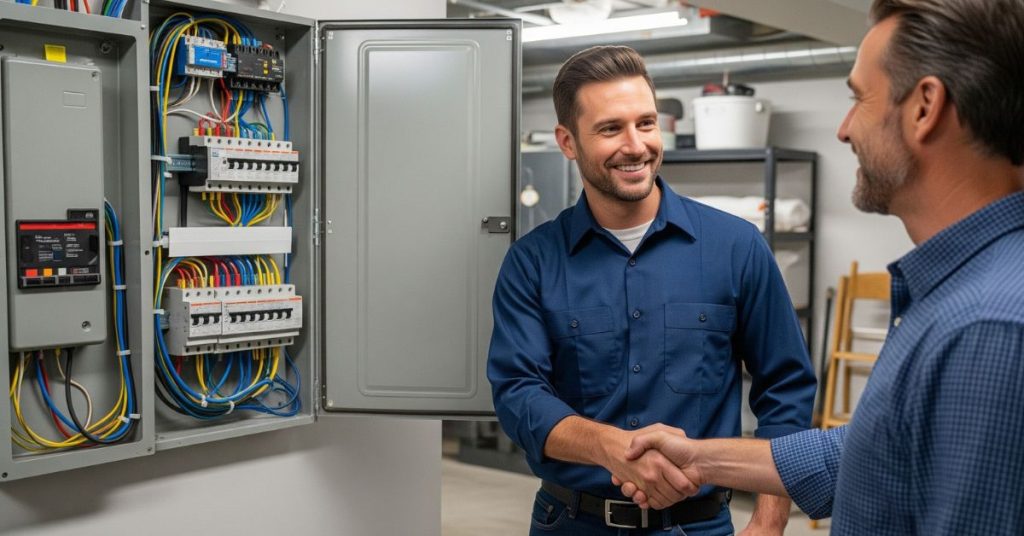Thinking about upgrading your electrical panel? This essential step not only improves your home’s safety but also ensures your system can handle today’s increasing power demands. Outdated panels can lead to frequent breaker trips, energy inefficiency, or even serious fire hazards if ignored. But before you make the move, it’s important to ask: what do electricians recommend for panel upgrade? In this blog, we’ll explore expert advice, safety tips, and practical considerations to help you make the best decision.
Why Electrical Panel Upgrades Are Essential

An electrical panel, often referred to as a breaker box, is the nerve center of your property’s electrical system. It distributes power to different circuits and ensures safety by preventing overloads. However, with the increasing demand from modern appliances, EV chargers, and home automation systems, older panels often struggle to keep up.
- Safety: Outdated panels may have faulty breakers, which fail to trip during surges.
- Capacity: Older homes often run on 60–100 amp panels, while modern living requires at least 200 amps.
- Resale Value: A new panel boosts property value and appeals to buyers who expect updated infrastructure.
- Energy Efficiency: Modern panels work more efficiently, reducing wasted energy and helping lower monthly utility bills.
- Compatibility: New panels are designed to support advanced technologies, such as solar power systems and backup generators.
- Insurance Compliance: Many insurance providers prefer or even require updated panels for coverage approval, reducing liability risks.
Signs That Indicate It’s Time for a Panel Upgrade
Knowing when to call an electrician for a panel upgrade is crucial. Some of the most common warning signs include:
- Frequent breaker trips when multiple appliances are in use.
- Flickering or dimming lights, especially when major devices start.
- Burning smell or scorch marks near the panel or outlets.
- Outdated fuse box instead of a modern breaker system.
- Buzzing or crackling sounds coming from the panel.
- Limited outlets and heavy reliance on extension cords.
If you notice any of these, it’s time to schedule a professional inspection.
Planning Your Electrical Panel Upgrade
Before proceeding, it’s important to plan carefully. Preparation ensures a smooth installation and avoids unnecessary costs.
- Assess Current and Future Electrical Needs
Consider today’s energy use along with future upgrades, such as EV chargers, hot tubs, or solar systems. - Consult a Licensed Electrician
DIY panel upgrades are dangerous and often illegal. A certified electrician will handle permits, codes, and safety requirements. - Budget for the Upgrade
Costs vary depending on panel size, wiring updates, and location. Typical upgrades range between $1,500–$3,500. - Secure Necessary Permits Electrical work requires permits and inspections to comply with local regulations. Your electrician will manage this process.
Choosing the Right Panel for Your Home
When selecting a new panel, capacity is key. Here are the most common options:
- 100-Amp Panel: Suitable for small apartments or homes with minimal power needs.
- 150-Amp Panel: Works for medium-sized homes with moderate electrical demands.
- 200-Amp Panel: The standard for modern homes with multiple large appliances and electronics.
- 400-Amp Panel: Best for luxury homes with extensive systems, pools, and EV chargers.
Your electrician will help determine the ideal size based on load calculations.
Step-by-Step Overview of a Panel Upgrade
While only licensed professionals should perform the upgrade, it’s helpful to understand the process:
- Initial Inspection – Evaluate the existing panel, wiring, and grounding.
- Power Shut-Off – Disconnect electricity to ensure safety during work.
- Removal of Old Panel – Carefully detach wiring and take out the outdated unit.
- Installation of New Panel – Securely mount the new breaker box and reconnect circuits.
- Load Balancing – Distribute circuits evenly across breakers to prevent overload.
- Grounding & Bonding – Ensure proper grounding for safety and code compliance.
- Inspection & Approval – Local authorities inspect the upgrade before restoring full power.
Safety Tips for Electrical Panel Upgrades
Even though electricians handle the heavy work, homeowners should keep these safety tips in mind:
- Never attempt DIY panel replacements. Handling electricity without proper training is extremely dangerous. Always rely on licensed electricians to ensure safe, compliant, and reliable panel upgrades.
- Keep the area clear. Maintain a clutter-free space around the electrical panel. This allows electricians to work efficiently and reduces hazards during maintenance or upgrades.
- Label circuits properly. Correctly labeling breakers prevents confusion, saves time during repairs, and ensures quick action in emergencies by clearly showing which circuit controls each area.
- Upgrade wiring if necessary. An electrical panel connected to outdated wiring remains unsafe. Replacing wiring prevents overloads, enhances performance, and ensures your system meets today’s energy demands.
- Install surge protection. Whole-house surge protection shields sensitive electronics and appliances from damaging voltage spikes, providing long-term safety, system reliability, and extending the lifespan of essential household devices.
How Long Does an Electrical Panel Upgrade Take?
Most panel upgrades can be completed within 8–10 hours, though larger projects may extend over two days. Factors affecting the timeline include:
- Number of circuits
- Condition of existing wiring
- Permit and inspection schedules
- Additional upgrades, such as grounding or new outlets
Proper planning minimizes downtime and ensures a smooth transition.
Cost Factors to Consider
Panel upgrade costs vary depending on several factors:
- Amperage size of the new panel
- Complexity of wiring and number of circuits
- Labor rates in your area
- Additional services, such as whole-home surge protection or rewiring
- Permit and inspection fees
While upfront costs may seem high, the long-term benefits of safety, efficiency, and peace of mind make this investment worthwhile.
Future-Proofing Your Electrical System
Upgrading your panel is not just about meeting today’s demands—it’s about preparing for the future. Consider:
- Smart home systems that require stable, high-capacity power.
- Solar panel integration for renewable energy savings.
- EV charger installation for eco-friendly transportation.
- Home additions or remodels that increase power needs.
Choosing a larger panel now may prevent the need for another costly upgrade later.
Benefits of Hiring a Professional Electrician

Working with a qualified electrician ensures:
- Code Compliance: Adherence to local and national electrical standards.
- Warranty Protection: Coverage on parts and labor.
- Enhanced Safety: Protection for your family and property.
- Expert Recommendations: Tailored to your lifestyle and energy needs.
- Accurate Load Calculations: Prevents future electrical problems.
- Peace of Mind: Professional installation guarantees your system operates reliably.
- Time Savings: Quick, efficient work that avoids costly mistakes from DIY attempts.
- Long-Term Value: Proper upgrades extend the lifespan of your electrical system.
- Up-to-Date Knowledge: Professionals stay current with the latest technologies and safety practices.
- Trusted Guidance: For projects like upgrading your electrical panel, you’ll know exactly what do electricians recommend for electric panel upgrade to ensure safety and efficiency.
Professional installation provides peace of mind and guarantees your electrical system operates reliably.
Final Thoughts
An electrical panel upgrade is one of the most valuable improvements you can make to your home or business. Not only does it provide enhanced safety and reliability, but it also ensures your system is ready to handle today’s growing electrical demands. From preventing overloads to supporting smart home technology, the right panel sets the foundation for a more efficient, future-ready property.
When planning this essential upgrade, don’t take chances with DIY or unqualified work. Call the trusted experts at Electricians Service Team. Our licensed electricians deliver professional, code-compliant installations tailored to your needs, giving you peace of mind and long-term value.
FAQs
If your panel is more than 25–30 years old or still uses fuses instead of breakers, it’s likely outdated. Signs like frequent tripping, burning smells, or buzzing sounds indicate it may be unsafe and should be inspected.
No—panel upgrades are complex, dangerous, and must be handled by a licensed electrician to ensure safety and code compliance. DIY electrical work can lead to serious injury, fire hazards, or failed inspections.
Most residential upgrades cost between $1,500 and $3,500, depending on the panel size, wiring, and location. Additional features like surge protection or rewiring can increase the price.
Not always, but if your wiring is outdated or not up to code, it’s best to upgrade it during the panel replacement. This ensures full system safety and compatibility with modern electrical loads.
Power is usually shut off for 6–10 hours during the upgrade process. Your electrician will coordinate to minimize downtime and restore service as quickly as possible.





